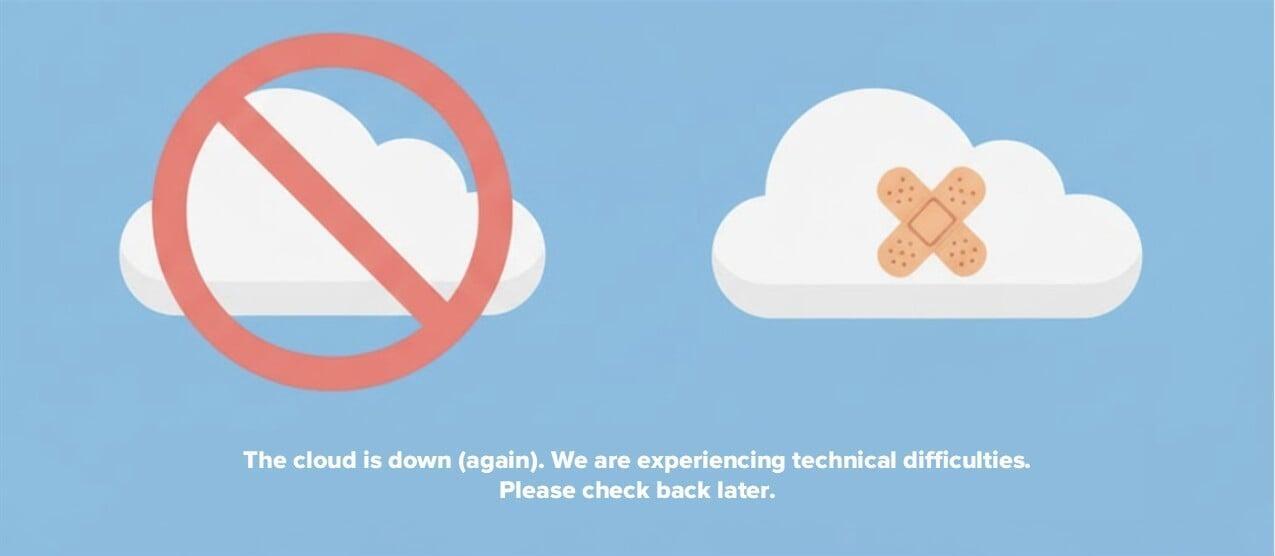Beyond the Cloud Blame Game: Why Multi-Vendor Resilience is Now a Non-Negotiable

The double punch of the AWS and Azure outages confirms the inevitable: your biggest threat is systemic concentration risk. We simplify the only true countermeasure: Multi-Region, Multi-Cloud, and Hybrid-Cloud design.
a six to eight minute read
The Mid-Market Guide to a Resilient Cloud Strategy
In Part 1, we established that the AWS US-EAST-1 outage was a massive, expensive lesson in Concentration Risk. A single regional failure, often triggered by simple human error, can paralyze a global economy.
But the subsequent, widespread Microsoft Azure outage—caused by an inadvertent global configuration change that impacted M365 and key enterprise services—delivered a decisive double gut-punch.
This back-to-back sequence of failures from the two largest hyperscalers proves a critical point: this is not about a bad vendor; it's about systemic risk. The question is no longer "Which vendor is safer?" but rather, "How do we design our business to survive when the largest vendors fail simultaneously or systemically?"
Blame is irrelevant. Resilience is everything. The only way to protect your business is to design your architecture to be vendor-agnostic at the points of critical failure.
Architecture 1: Multi-Region Redundancy (Defense Against Localized Failure)
The first, essential layer of defense remains Multi-Region Redundancy.
The Necessity of Geographic Separation
Multi-Region means placing copies of your mission-critical applications and data in physically distant geographic zones within the same cloud platform. If your primary deployment is in US-EAST-1, your failover is in US-WEST-2.
This setup is the direct countermeasure to the risk exposed by the AWS outage. Since the root cause was geographically confined (a regional human error), having a properly configured Multi-Region backup would ensure your Recovery Time Objective (RTO) is met.
The Single-Vendor Limitation
However, the Azure outage exposed the flaw in stopping at this level of defense.
Azure's failure was tied to a global configuration error affecting services like Azure Front Door. This type of systemic, vendor-wide mistake—a governance flaw at the core of the provider's network—can sometimes transcend regions and Availability Zones (AZs) within the same platform. If your primary and failover regions are governed by the same flawed configuration, they can both be rendered inoperable by the same systemic event.
The pragmatic takeaway is clear: Multi-Region design is necessary, but it is no longer sufficient. It defends against local error, but not always systemic vendor error.
Architecture 2: Hybrid and Multi-Cloud (Defense Against Systemic Failure)
To neutralize the risk of a single vendor’s systemic failure (the "Azure problem"), you must diversify your critical points of failure across distinct governance boundaries. This requires a strategy that moves beyond a single provider.
The Ultimate Anti-Concentration Strategy
This is where Hybrid-Cloud and Multi-Cloud become non-negotiable for any mid-market business serious about resilience:
Hybrid Cloud: Combining a public cloud environment (e.g., AWS or Azure) with a dedicated on-premise or private data center. This provides a completely separate, non-vendor-dependent failover layer, often used for highly sensitive data or applications with strict latency requirements.
Multi-Cloud: The intentional use of two or more distinct public cloud vendors for different functions or applications. For example, using AWS for one mission-critical application and Azure for another, or leveraging Vendor X for UCaaS and Vendor Y for your ERP.
Multi-Cloud is the ultimate defense against vendor-specific Concentration Risk. When a root cause is a global DNS or configuration issue on Vendor A, having your failover or business-critical application running on Vendor B ensures true continuity. By distributing your critical functions, you maintain leverage and agility.
Practical Sourcing for Resilience (The C9 Principle)
Adopting a Multi-Cloud approach does not have to mean a massive increase in complexity or cost. In fact, when done strategically, it often simplifies operations through Strengths-Based Sourcing.
Instead of accepting a single vendor's "good-enough" solution for every application, you gain the power to select the absolute best-fit vendor for each job. This commitment to intentional, diversified sourcing is one of our core principles in action: reducing risk by choosing technology that fits your architectural need, not just the vendor you already have a contract with.
The C9 Value Bridge: From Design to Decision
The blueprints for resilience are clear: utilize Multi-Region for localized defense and implement a Hybrid or Multi-Cloud strategy for systemic defense.
However, designing this architecture is only half the battle. The new complexity barrier for the mid-market is implementing these diverse architectures without dramatically increasing management complexity and cost.
This is where the need for strategic guidance becomes apparent. You need an expert adviser to help you:
Map Dependencies: Clarify which of your critical applications must be diversified.
Define Architecture: Clearly define the non-negotiable resilient design for each application.
Source Intentionally: Navigate the multi-vendor ecosystem to procure the precise mix of services and contracts needed to execute the resilient design efficiently.
Seek out a neutral, expert adviser, removing the Complexity Fatigue and Decision Paralysis that lead to Concentration Risk in the first place. We ensure your resilient architecture is purchased strategically, reducing both your risk exposure and your overall technology spend.
What's Next?
You have the architectural blueprints. The AWS and Azure failures have given you a clear mandate to diversify.
The final, critical step is making sure your budget and contracts actually align with this resilient design. In Part 3, we shift the focus entirely to the procurement table, demonstrating how your sourcing strategy is your most powerful Disaster Recovery plan, and how neutral advisory simplifies that final, crucial move.

